|
|
Desmond

|
|
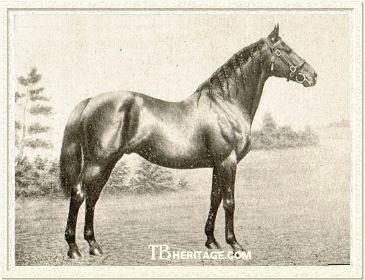 |
|
|
Desmond's success as a juvenile racehorse raised justifiable expectations of classic success the next season, but he thoroughly dashed those hopes by failing to place in every contest at age three. "It was quite apparent ... that he was not particularly in love with racing," his breeder and owner wryly reflected. "It cannot be said he retired enshrined in glory, and he had to make his future success by sheer merit. This, I think, he has to a very considerable extent, accomplished." When the Irish peer Wyndham Thomas Windham-Quin, 4th Earl of Dunraven and Mount Earl, made that observation in 1912, his horse had been among the top ten leading sires in the U.K. for more than six years, consistently improving his mares and populating race courses in England and Ireland with speedy, successful juveniles and some tough, game winners of the most important staying races. The next year he would top the sires list.
Desmond's sire was St. Simon and his dam was a winner of the classic Oaks Stakes. St. Simon, unbeaten on the track for the 6th Duke of Portland, was the most dominant sire of the time at the time of Desmond's birth in 1896, having sired the winners of nine classic races to that year, and his sons St. Frusquin and Persimmon were to add more classic glory for their sire that season.
Festive and L'Abbesse de Jouarre
Desmond's dam was L'Abbesse de Jouarre, a diminutive black daughter of Trappist. By Derby winner Hermit, Trappist was inclined more to sprinting, accounting for the July Cup, All-Aged Stakes, and Steward's Cup during his racecourse career. He was durable, winning twenty-four times. He was not a fashionable stallion, and the best he ever sired was his little black daughter out of the Carnival mare Festive.
Festive was of little account on the racecourse, winning but one small race and £100. Her sire, Carnival, was an indifferent son of Sweetmeat. She was a member of the Agnes branch of Family #16. This family was responsible for such important individuals as Miss Agnes, Little Agnes, Marcion, St. Gatien, Lily Agnes, Martagon, Kendal, Farewell, and Ormonde. James Snarry acquired Festive. Once a stud groom at the famed Sledmere Stud, he came into the ownership of a scrawny filly out of Polly Agnes when the stud's owner, Sir Tatton Sykes, was so affronted by the filly's weedy looks, he gave her to Snarry on the condition she be removed from his stud as soon as was feasible. Later, Snarry made a tidy sum when selling the filly, named Lily Agnes, to the 1st Duke of Westminster, for whom she bred classic winners Farewell and Ormonde. Now Snarry had another member of this family in Festive, and he sent her to Trappist. Her first was the colt The Black Prince, a winner of the Fitzwilliam Stakes at Doncaster. Then, in 1886, came L'Abbesse de Jouarre. Sent as a yearling to the Doncaster sales, she was not one of the prize lots, being small, by a less-than-fashionable sire, and out of a mare which had possessed little racing ability and had produced but one winner. Nevertheless, Dunraven, along with Lord Randolph Churchill, father of the future Prime Minister, saw something in her, and paid £300 for her and raced her in partnership.
Lady Randolph Churchill, the former Jennie Jerome, daughter of American financier and sportsman Leonard Jerome, recalled many years after the conclusion of L'Abbesse de Jouarre's racing career, "The shining light of our stable was L'Abbesse de Jouarre, for which Randolph gave £300 at the Doncaster sales. I had been reading L'Abbesse de Jouarre, written by Ranan in order to disprove the assertions of his friends that he could not write something in a light vein. I had suggested the name as a fitting one for the beautiful black mare, which was by Trappist out of Festive. She was a gallant little thing, with a heart bigger than her body, and her size made the public so skeptical, that she invariably started at long odds. When she won the Oaks, those who backed her got 20-1. Neither Randolph nor I saw that performance. He was fishing in Norway, and I was spending a few days with some friends who had a house on the Thames. I remember being in a launch on the river and reaching Boulter's Lock shortly after the hour of the race. On my asking the lockkeeper which horse had won the big race, he replied to my great delight and amusement, "The Abesse on the Jaw."
|
| 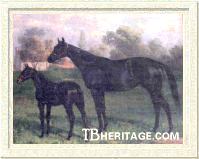
L'Abbesse de Jouarre with Desmond. Image courtesy of the Earl of Dunraven.
|
|
L'Abbesse de Jouarre won the Manchester Cup at age four, and the Hardwicke Stakes at five. The Earl of Dunraven and Lord Churchill retired her to the broodmare ranks, and her foals were bred in the name of the Earl. She produced three foals: a Galopin colt named Cowl, which amounted to nothing, and full siblings by St. Simon, the filly Festa and her younger brother Desmond. L'Abbesse de Jouarre died in the spring of 1897 at Welbeck while delivering a dead foal by Isinglass.
Festa was a winner of only two races. She was sold to the Waldfried Stud of Germany, where, as the dam of five important stakes winners -- Faust, Festino, Fervor, Fabula, and Fels -- she became one of the most noted broodmares in German breeding.
|
Desmond was a compact individual, dark brown (sometimes called black) in color with a strong shoulder, short back, and powerful hindquarters. He was a handsome colt and displayed talent, attracting unsolicited offers for him, including the extraordinarily high proffer of 4,000 guineas from sportsman and breeder Richard Croker. The Earl declined, electing to keep him for his own stable. Desmond was sent to the St. Gatien's House, Newmarket, yard of Robert Sherwood.
Desmond on the Turf
At two, Desmond started seven times for three victories. His first race was the Brocklesby Stakes at Lincoln in March of 1898. He finished second to Amurath. After a short rest, he re-appeared in May at Epsom in the Woodcote Stakes, in which he was beaten a scant head by the Bend Or filly Fairy Gold, destined to become one of the cornerstones of August Belmont's Nursery Stud in Kentucky. Desmond then won three straight races, the Summer Breeders' Foal Plate at Manchester, the Coventry Stakes at Ascot, and the July Stakes at Newmarket. He closed out his season with thirds in the Champagne Stakes at Doncaster and the Dewhurst Plate at Newmarket.
Desmond made his first start as a three-year-old in the Two Thousand Guineas. He disappointed badly, finishing seventh to the Duke of Westminster's brilliant Flying Fox. In his next start, a welter plate under Tod Sloan, he refused to start, and when he finally got away, he was well behind the rest of the field, finishing a dismal thirteenth. He was fifth in the Derby, won by Flying Fox, fifth and last in the Rous Memorial at Ascot, and fifth in the Sandown Foals Stakes at Sandown. While Flying Fox went on to capture the St. Leger and the Triple Crown, Desmond was ignominiously retired to stand at the Earl's Fort Union Stud in Adare, Co. Limerick, Ireland.
Desmond in the Stud
Desmond's stud fee reflected his disappointing record, for he serviced mares at an initial fee of 25 guineas. Breeders were at first in no hurry to beat a path to his breeding shed, and his first yearling to be offered at public auction fetched an insulting two guineas. However, the more horsemen saw of his yearlings, the more they liked them, for they were judged to be very good looking and most came to hand early. Like his sire St. Simon, Desmond was a dominant for bay or brown in his offspring, and many of his youngsters proved to be brilliant juveniles. After nine years at stud, with numerous successful winners in Ireland and England, his yearlings were selling at public auction for an average of 1,000 guineas. He first broke into the ranks of the leading sires in 1905, placing ninth on the list, with nineteen winners of thirty-eight races. After that, excepting 1906, when he was thirteenth on the list, he was never out of the top ten leading sires, rising to third in 1907 and 1912, and heading the list in 1913, with twenty winners of 42 races worth 30,973 pounds (Sundridge was second with seventeen winners), the year of his death. He remained in the top ten posthumously, 1914-1916.
Desmond's first crop, which hit the ground in 1901, included three good ones: EARLA MOR (a bay colt out of Weeping Ash, by Ashplant), ISALIAN BEAUTY (a filly out of Marietta, by Kendal), and TAMASHA (a brown colt out of Natasha, by Favo). These three won seven races between them. ISALIAN BEAUTY overcame lameness from a horseshoer's nail and pain from bad teeth to win two races at two, the Crabbet Plate at Gatwick and the Free Handicap at Newmarket, beating sixeten. EARLA MOR won several races at two and three, and at four, took the Duke of Cambridge's Handicap at Newmarket; he was later a useful stallion that made the top twenty in the sires list in England twice. While not ill-bred, none of these winners could be said to have stellar pedigrees, and their success, and those of Desmond's other youngsters out of modest mares in the first few years, brought him better mares and a successively increasing stud fee.
The scintillating Derby of 1913 was dominated by two of Desmond's most famous sons. They were ABOYEUR and CRAGANOUR, colts whose names became enshrined in the lore of the British turf.
|
| 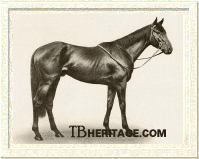
Aboyeur
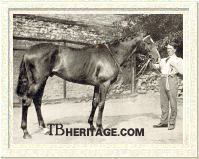
Craganour
|
|
ABOYEUR was a bay colt bred in Ireland, out of Pawky, a non-winning daughter of the Barcaldine son Morion. CRAGANOUR'S pedigree was far more illustrious. A bright bay, he was out of the Laveno mare Veneration, a half-sister to Pretty Polly. Veneration was foaled at the Eyrefield Lodge Stud in Ireland, bred by Major Eustace Loder. She was sold to Sir Tatton Sykes, with her colt foal by Desmond, and send to the Sykes Sledmere Stud in north Yorkshire. Purchased as a yearling at the Doncaster sales for 3200 guineas by Bower Ismay, the colt was named CRAGANOUR, after a hill in Scotland where his new owner enjoyed grouse shooting. Ismay was the younger brother of Bruce Ismay, the chairman of the White Star Line, who was on board and survived, when the line's new flagship, Titanic, went down in the north Atlantic on the night of April 15, 1912.
CRAGANOUR won his debut in the New Stakes at Ascot, and went on to become the best two-year-old of 1912, winning the Exeter Stakes at Newmarket, the Champagne Stakes at Doncaster, the Prince of Wales's Plate at York, and the Middle Park Plate at Newmarket. His only defeat was a second to Rock Flint in the Molecomb Stakes at Goodwood.
ABOYEUR, owned by a group of gamblers who were styled the "Druids Lodge Confederacy," was not so successful on the racecourse. He did win the Champagne Stakes at Salisbury, but was twice unplaced in his other starts that season.
|
CRAGANOUR suffered a surprising defeat in the Union Jack at Liverpool in his prep for the Two Thousand Guineas, but rebounded to miss only by a head to Louvois in the classic. Many thought the finish judge had erred, as the two colts finished so wide apart, but the result stood. Ismay and trainer W.T. Robinson elected for a jockey change to Danny Maher for the Newmarket Stakes, which CRAGANOUR won easily, setting him up as the favorite for the Derby. ABOYEUR, meanwhile, had finished unplaced in his only start at three, sending him off to Epsom as a rank outsider.
As Maher was committed to ride a runner for Lord Rosebery in the Derby, the connections of CRAGANOUR had to go to France for the services of Johnny Reiff to guide their colt at Epsom. What happened during the running of the race has been the subject of turf lore and controversy ever since. The race was marred when the suffragette Emily Davison bolted onto the track at Tattenham Corner, and pulled down the King's horse Anmer. Neither rider nor horse was hurt, but Miss Davison sustained a fractured skull, from which she succumbed days later. CRAGANOUR, ABOYEUR and the bulk of the field were well past this, driving for the finish. Amid all the bumping and jostling, it looked as if CRAGANOUR had prevailed by a head from ABOYEUR. After a celebration in the unsaddling enclosure, the stewards announced they were objecting to the winner. The connections of ABOYEUR made no objection. It was left to the stewards Major Eustace Loder, Lord Rosebery, and Lord Wolverton. Rosebery recused himself, having had a runner in the race. Their decision was that CRAGANOUR had been the main culprit in the jostling to the finish and had impeded the run of ABOYEUR. The result was that CRAGANOUR'S number was taken down and he was placed last. The race was awarded to ABOYEUR in the first disqualification since the scandal of Running Rein in 1844. Ismay appealed three days later, but he was a day too late, and ultimately dropped legal action. The decision to disqualify CRAGANOUR remained controversial for years, with theories abounding as to the reasons behind it, ranging from prejudice against the Ismay family because of the Titanic disaster, to the more salacious tale of Major Loder loathing Ismay for once having had an affair with Loder's sister-in-law. What was not mired in controversy was the fact Desmond sired the winner of the Derby, an accomplishment that helped vault him to the top of the British sire list that season.

1913 Derby, Drive to the Finish: Desmond's sons Craganour and Aboyeur (with blinkers) head-to-head
The lives of the two Desmond colts took very different paths thereafter. Ismay sold CRAGANOUR only weeks later to Senor Martinez de Hoz, master of the Chapadmalal Stud in Argentina for £30,000, with the stipulation the colt never race again. CRAGANOUR was shipped to the Argentine forthwith, where he became a great success. The Handicap Craganour, run at San Isidro in Buenes Aires is named in his honor.
ABOYEUR raced twice more after the Derby and was beaten on both occasions. He was sold for £13,000 to the Imperial Racing Club of St. Petersburg, and exported to Russia, where he disappeared during the Russian Revolution. A fanciful tale that had ABOYEUR and Minoru, another Derby-winning expatriate, being evacuated to Serbia by the British Military Mission, was never corroborated. Two stallions were evacuated, but their identities were never verified. Another unverified tale had the last sighting of ABOYEUR in Russia, just after the Revolution, pulling a cart. A third story had ABOYEUR and Minoru turning up in Constantinople with White Russian refugees after the war. Officially, however, ABOYEUR, Minoru, classics-placed Louviers, and trotting champion Cresceus all remain listed as vanished during the turmoil of 1917.
At stud in Argentina, CRAGANOUR excelled. He was second on the Argentine sire list in 1919, third in 1921, 1928, and 1929, and fourth in 1922, 1926, and 1927. CRAGANOUR led the Argentine broodmare sire list in 1936. His son Caricato was victorious in the Gran Premio Jockey Club and the Gran Premio Polla de Potrillos (Two Thousand Guineas) in 1918. Another son, Buen Ojo, won the same two races in 1919. Daughters Ceramica won the Gran Premio Polla de Potrancas (One Thousand Guineas) in 1921 and Pilmayqyen took the Gran Premio Seleccion (Oaks) the following year. One of the most notable performers out of a Craganour mare was Pico Flor, winner of the Grande Premio Diana (Brazilian Oaks) in 1937.
GLORVINA (1911), a bay full sister to CRAGANOUR, ran a fine second to Princess Dorrie in the One Thousand Guineas as a three-year-old. Although none too successful a producer herself, GLORVINA founded a tail-female line which has brought forth over the generations multiple English stakes-winning filly Kitty Girl, English stakes winner Sporting Yankee, and American stakes winner and sire Hurry to Market.
|
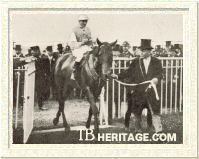
The White Knight
|
|
Desmond sired an outstanding cup horse in THE WHITE KNIGHT (1903). He was a bay colt, produced from the Buckshot mare Pella. At three, he captured the Queen's Vase and the Newbury Autumn Cup. At four, he took the Coronation Cup, Goodwood Cup, and the Ascot Gold Cup, was second to another outstanding cup horse, Radium, in the Jockey Club Cup, and third to Velocity in the Doncaster Cup. His bravest performance came in the Cesarewitch Handicap, in which he lost by less than a length to the mare Demure, while attempting to concede her 45 pounds. At five in 1908, THE WHITE KNIGHT again won the Coronation Cup and Ascot Gold Cup, and was third to Radium in the Goodwood Cup. In notching his second Ascot Gold Cup victory, The White Knight accomplished something not done since Isonomy won the Ascot Gold Cup in 1879 and 1880.
|
THE WHITE KNIGHT was not an outstanding sire, and is not to be confused with another horse named simply White Knight, the sire of American stallion McGee. One of The White Knight's daughters, Kuningada, after exportation to the southern hemisphere, produced Three Kings, a winner of the Adelaide Cup.
|
| 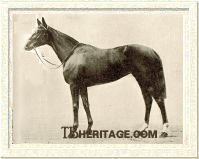
Knockfeerna
|
|
KNOCKFEERNA (1908) was one of Desmond's high-class daughters. Her dam was a full sister to Pretty Polly named Adula, who herself showed some quality on the course, accounting for the Park Hill Stakes at Doncaster. Knockfeerna, unlike her dam and aunt, was not a chestnut, but a brown, with her sire's short back and good shoulder. Her racing quality was beyond question. At two, she was third in the National Breeders' Produce Stakes. Like Pretty Polly, she scored in the Cheveley Park Stakes, and also captured the Great Lancashire Breeders' Produce Stakes. At three, she was third to Atmah in the One Thousand Guineas, but rebounded to take the prestigious Coronation Stakes at Royal Ascot. As a broodmare, records for Knockfeerna show she had one colt that reached the races, a Spearmint colt named Svengali that won a race as a three-year-old in 1920.
|
DESTA (1908) was another good racing daughter. She was a bay produced from the Plebeian mare Gold Anchor. DESTA'S most important victory came in the 1911 Oaks d' Italia. As a broodmare in Italy, DESTA produced a Havresac II colt named Dervio, who captured the Derby Italiano. Dervio was not highly regarded, even with his classic victory, and was gelded soon after.
Desmond was the sire of a multiple Polish classic winner in the black filly DIVINE (1912). Her dam was the Gallinule mare Vira. In 1915, this brilliant daughter of Desmond captured the Nagroda Liry (Oaks), the Nagroda Przychowku, and the Przewodniczacego Rady Panstwa (Derby). With the tumult of World War I, it is not known what happened to her after her brilliant classic season, for there are no records to show she ever produced any foals. DOLOMIT (1911), out of Miss Churchill, by Ruler, another Desmond offspring that raced in Poland, captured the Nagroda Derby in Poland in 1914.
|
| 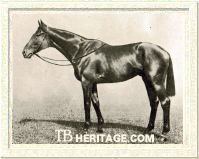
Lomond
|
|
LOMOND (1909), bred at Fort Union Stud, was a bay colt produced from the Alloway mare Lowland Aggie. He was victorious in six races during his career, including the New Stakes, Gimcrack Stakes, St. James's Stakes at Kempton Park, the Norfolk Stakes and the Trial Stakes at Ascot. The majority of his wins came at two, making him highly fancied for the Derby of 1912. However, things conspired against the colt, and he never even made it to the Derby. He returned at four to run fifth to Tracery in the Eclipse Stakes and notch his victory in the Trial Stakes.
|
LOMOND stood first in Great Britain, and later in life, in Argentina. His most notable offspring was Loch Lomond, winner of the 1919 Irish Derby and other races that made LOMOND champion sire in Ireland in 1919. A gelded son of LOMOND named Ben Lomond, raced in Australia, where he was a winner of the SAJC Goodwood Handicap. In Argentina, LOMOND sired Lacio, winner of the Gran Premio Nacional, and a daughter, Kilkerley, produced Roi de Trefle, another winner of the same race.
LOMOND'S son, Loch Lomond, sired Old Orkney, winner of the 1929 Goodwood Cup. Loch Lomond's daughter, Cooleen, foaled in 1928, was talented over the fences, winning the Lancashire Steeplechase and placing second to Battleship in the 1938 Grand National at Aintree. Cooleen became the dam of Shagreen, winner of the Grand Sefton Chase in England and the Irish Grand National.
The venerable Pretty Polly was a visitor to Lomond's court. The resulting foal, a bay colt, was Clackmannan (1919). This colt won six races and dead-heated for another. Sent to Japan for stud duty, Clackmannan emerged as Japan's leading sire in 1933 and 1934.
The Irish-bred DEMOSTHENES (1907), was a brown colt out of the Chittabob mare Carlin. Not only was he a racecourse performer of high class, he was also the first son of Desmond to give indication that his sire was on his way to becoming a sire of sires. During his racing career, Demosthenes won the Stewards' Handicap at Epsom and placed second in the City and Suburban Handicap and third, to Bachelor's Double, in Ascot's Royal Hunt Cup. Exported to New Zealand for stud, he became that country's leading sire in 1919/20. His best were Auckland Cup winner Karo; two-time Trentham Gold Cup winner Amythas; Auckland Cup winner Oratress, who in her turn produced another winner of the same race in her daughter Oratrix; and Great Northern Derby winner Gasbag. Demosthenes scored his biggest success as a stallion when his son Statesman crossed the Tasman and captured the Melbourne Cup in Australia. As a broodmare sire, Demosthenes was responsible for another winner of the Auckland Cup in Concentrate and a Great Northern Derby winner in Star Stranger. |
| 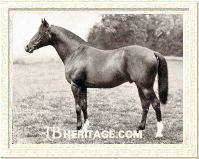
Limond
|
|
LIMOND (1913, from Lindal by Kendal) was another Desmond son that found success as a stallion in Australasia. Bred and raced by James Russel, he won one race, the Exeter Stakes at Newmarket, in three starts at age two. At age three the big, 16.1 hand colt went unplaced in the Two Thousand Guineas and in a mile race at Gatwick, and then broke down. Briefly owned on speculation by the British Bloodstock Agency, and then by Edward Moorhouse, he had four seasons at Newmarket, visited by only a dozen less-than-stellar mares at the low fee of 18 guineas during those years. He got a promising colt in Limosin, whose racing career was cut short due to a serious problem with thrush. Limosin was later a winner of King's Premiums and Super-premiums at the Islington horse show and used primarily as a hunter sire.
|
In the spring of 1921 LIMOND was sold to New Zealander G.M. Currie, owner of the New Zealand leading sire, Absurd. Despite his poor race record, and minimal showing as a stallion, Currie was attracted to LIMOND -- DEMOSTHENES was already making a name for himself in New Zealand, and, in addition, LIMOND had the Sunshine family blood on his dam's side and through her was closely related to the great New Zealand stallion Martian, and, in England, to Phalaris.
Installed at Currie's Koatanui Stud in New Zealand, he was, at first, second fiddle to Absurd, and in his first season there got only six foals, but four of them became winners, and one, Mask, would win the Great Northern St. Leger. His next crop included Commendation, winner of the New Zealand Derby, Great Northern Derby, New Zealand St. Leger and Great Northern St. Leger, a feat never before accomplished. Limerick, a winner in New Zealand and Australia of £38,729, and described as "the most brilliant horse seen in Australia for many years," was another in this crop; unfortunately, both Commendation and Limerick were gelded. By the time they had finished their three-year-old season, LIMOND was in great demand, with a stud fee of 200 guineas and he continued fully booked until the end of his stud career. He was champion sire in New Zealand in 1930/31 and champion sire in Australia in 1931/32. In all, his New Zealand and Australian winners included winners of nine Derbys, ten St. Legers, eight Oaks, and nine Guineas; his get could win at all distances, and a number won over fences. He got several sire sons, most of which raced and stood in Australia, including Veilmond, who continued the line. LIMOND died at the age of 23 in 1936 at Koatanui Stud.
Another Desmond colt to make his way to Australasia was SEREMOND (1910), a brown colt out of Serenata, by Chevening. He won Goodwood's Richmond Stakes and was third to CRAGANOUR and Shogun in Doncaster's Champagne Stakes at two, and at age three, was winner of some small races and third in the St. Leger to Night Hawk. Imported into Australia by C. McDougall, he stood his entire career at Lyndhurst Stud at Darling Downs. He got many winners, particularly in Queensland, among them the champion juvenile Mollison, later a brilliant sprinter, and was third on the leading sires list in Australia in 1927-28. He died in 1934.
|
| 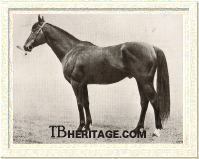
Charles o'Malley
|
|
Another of Desmond's sons, the bay CHARLES O' MALLEY (1907), not only was a good performer on the racecourse, but an important broodmare sire. Charles O'Malley was bred by Colonel William Hall Walker and foaled at Walker's Tully Stud in Ireland and raced for A.P. Cunliffe. His dam was the Isinglass mare Goody Two-Shoes, a game little race mare who had lost an eye in a racing accident. Charles O'Malley, like many Desmonds, was a good performer at two, accounting for Ascot's New Stakes, Newcastle's Seaton Delaval Plate, Goodwood's Richmond Stakes, and Manchester's Autumn Breeders' Foal Plate, in the latter giving away 19 pounds and winning by three-quarters of a length. At three, CHARLES O' MALLEY won the Windsor Castle Stakes over 11 furlongs, ran third to Lemberg and Greenback in the Derby the next week, and at Ascot took the two-mile Ascot Gold Vase, beating nine; he went to France to run in the Grand Prix de Paris, but could only place fourth (with Lemberg behind him).
|
At age four he ran second to Mushroom in Newmarket's March Stakes, and was second to Lemberg in Epsom's Coronation Cup, but the goal for the season was the Ascot Gold Cup. Touched with the spurs -- which he could not stand -- by jockey Steve Donaghue before the start of the Gold Cup, he promptly threw Donaghue off, knocking him out. Donaghue remounted, and lost the race by a neck to Willonyx; upon his return to the paddock, Donaghue asked, "When do we start?' He was still dazed, and actually did not know the race had been run! The marvel, is therefore, not that Charles O'Malley was beaten, but that he went so near to winning." At age five he won a race at Kempton Park, did not place in the Coronation Cup and Ascot Gold Cup, and was second to Jackdaw in the Alexandra Plate, after which, having been deemed to have lost his form, he was retired.
At Greenfields Stud in Tipperary (Ireland) CHARLES O' MALLEY got several nice performers, and was among the top ten leading sires three times. His winners included Cambridgeshire Handicap winner Zinovia; Cesarewitch Handicap winner Light Dragoon; Chesterfield Stakes winner Legality; and Pharmacie, unbeaten at age two, and a winner of the July Cup and All-Aged Stakes at four in 1922. Pharmacie became the dam of important French stallion Bacteriophage, sire of many major French stakes winners and grandsire, through his daughter, Biologie, of Prince Bio. The only classic winner sired by CHARLES O' MALLEY was the filly Charlebelle, winner of the Oaks in 1920. Syndicated in 1920 for £40,000, he remained at Greenfields, but broke his leg in a paddock accident in February of 1922, and had to be destroyed, after nine seasons at stud.
CHARLES O' MALLEY'S lasting fame rests with his daughter Malva, foaled in 1919. Out of the Robert le Diable mare Wild Arum, she was a small brown filly who won only three races from eighteen starts at two and three. She was bred and raced by the 5th Earl of Carnarvon, sportsman and Egyptologist, at his Highclere Stud. Upon his death in Egypt 1923, allegedly from an infected mosquito bite only months after participating in the opening of the tomb of King Tutankhamun, Malva became the property of his widow. But the small mare was so little thought of by the dowager countess, she gave him to her son, the 6th Earl and his wife. Malva produced eleven foals, including Eclipse Stakes and Coronation Cup winner King Salmon, who also ran second in the Two Thousand Guineas and Derby; His Grace, a dead-heat winner of the Coronation Cup; and Blenheim, purchased as a yearling by the Aga Khan, for whom he won the Epsom Derby in 1930. Blenheim sired a Derby winner in Mahmoud and Italian champion Donatello during his stud career in England, and after exportation to America, got outstanding performers A Gleam, Fervent, Jet Pilot, Mar-Kell, and American Triple Crown champion Whirlaway.
HAPSBURG (1911, from Altesse by Amphion). bred by Sir Tatton Sykes at Sledmere Stud, was purchased by Cecil Boyd-Rochfort on behalf of German émigré Sir Ernst Cassel for 3200 guineas. At two, Hapsburg won the New Stakes at Ascot in his racecourse debut, and went on to take the British Dominion Two-Year-Plate at Sandown and the Great Lancashire Breeders' Produce Stakes at Liverpool. He finished his season unplaced behind By George! in the Imperial Produce Plate at Kempton Park.
At age three he was fourth in the Two Thousand Guineas won by Kennymore, third to Corcyra in the Newmarket Stakes, a good second to Durbar in the Derby, and second to Corcyra in the Ascot Derby. Hapsburg finally broke through in the Eclipse Stakes at Sandown in July, winning by two lengths from Honeywood, with Guineas winner Kennymore third. He went on to run unplaced in the St. Leger won by White Eagle, and lost two of his last three races. His last victory was in the Champion Stakes at Newmarket against one opponent.
Hapsburg did well as a sire, represented by Chapeau (Ebor Handicap), Happy Girl (Whatcombe Handicap), Francis Joseph (Richmond Handicap at Kempton, Perhaps So (Stewards' Cup), and Noble Star, a foal of 1927 that won the Ascot Stakes, Cesarewitch Handicap, Jockey Club Cup, and Goodwood Stakes.
|
| 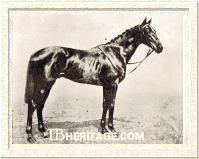
Sir Archibald
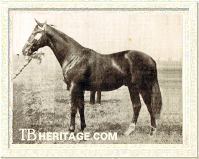
Stornoway as a yearling
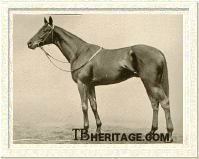
Atheling
|
|
Altesse also bred HALL CROSS (1909), an elder brother to HAPSBURG. He was a good two-year-old, capturing the British Dominion Two-Year-Old Plate at Sandown, and the Great Lancashire Breeders' Produce Stakes at Liverpool. At three, he was third in the Two Thousand Guineas won by Sweeper. He was exported to Brazil for stud duty.
SIR ARCHIBALD (1905) was a black colt out of Arc Light, by Prism. He was a good two-year-old, his principle victory coming in the New Stakes at Ascot. At three, Sir Archibald was second to Norman in the Two Thousand Guineas, and at four, he captured the Rous Memorial Stakes at Ascot. At stud, in England, and later in Italy, Sir Archibald was not outstanding, but got his share of winners. His son, Irish Elegance garnered victories in the July Cup, Royal Hunt Cup, Cambridgeshire Hunt Handicap, Portland Plate, and the Salford Borough Handicap. His daughter Heronicas was a stakes winner in Italy.
Another good Desmond juvenile winner was STORNOWAY (1911), a brown colt out of Sisterlike, by Ladas. He won the Gimcrack, Biennial, Clearwell, and Norfolk Stakes at age two. At stud, he sired Roseway, victress in the 1919 One Thousand Guineas and second to Bayuda in the Oaks. Roseway, after exportation to the United States, became the dam of the American stakes winner Rushaway (by Haste).
ATHELING (1913), out of Cyllene's daughter Wood Daisy, was another smart two-year-old, capturing the Hopeful Stakes and the Dewhurst Stakes over Lord Derby's highly regarded Chaucer filly, Canyon. At three, ATHELING placed third to Hurry On in the September Stakes, the wartime St. Leger substitute run at Newmarket. Atheling spent a good portion of his stud career in the United States, where he got some minor stakes winners.
|
|
The Earl of Dunraven bred the colt FARASI (1903) from his mare Molly Morgan by Morgan. Racing for T. Jones Nowlan, FARASI won only three of twenty-two starts, but his wins included Newcastle's Monkchester Stakes and the Richmond NurseryHandicap. His most significant achievement at stud was to sire the filly Athasi. She became an extraordinary broodmare. Sent several times to the stallion Blandford, she produced Doncaster Cup winner Athford; Imperial Produce Stakes winner Harina; Irish Derby and Irish St. Leger winner Harinero; and Trigo, winner at two of the Anglesey Stakes and Railway Stakes and the Epsom Derby, St. Leger, and Irish St. Leger at three in 1929, the year FARASI led the English broodmare sire list. |
| 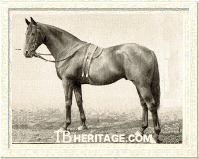
Declare
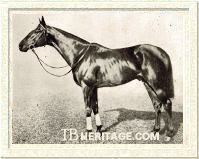
Land League
|
|
Some of the other noteworthy performers Desmond sired included MAYA (1904), a bay filly out of Gyp, by Grafton, whose biggest win came in the Newmarket Autumn Cup as a four-year-old.
DECLARE (1906), a bay colt out of Darling Clara, by Transept, a true stayer, won six races, notably the Somershire Stakes, Coombe Autumn Plate, and the two mile Ascot Stakes, but, despite a full book in his first few seasons at Sheffield Lane Paddocks, was a disappointment at stud.
DESMAN (1908), out of the Isinglass mare Inheritance. Desman was unsuccessful on the racecourse and had limited success at stud, but did come up with Happy Man, winner in 1923 of the Ascot Gold Cup.
SHANID-A-BOO (1902) was a good performer from one of Desmond's early crops, accounting for the Nursery Handicap at Kempton Park as a two-year-old.
LAND LEAGUE (1903), a brown colt out of Carbine's daughter Combine, was a winner of the Cambridgeshire Handicap at four. During his career, Land League won a total of 33 races, including eleven of twelve at age four, his Cambridgeshire victory being his most important. At stud, he failed to sire anything that possessed his own level of talent. |
Desmond's Broodmare Daughters
In early 1913, shortly before his death, Desmond had the great champion Pretty Polly brought to his court. The result was a bay filly, MOLLY DESMOND (1914). Not only was she a classy racetrack performer, she was an outstanding broodmare. On the race course at age two, Molly Desmond was victress in the Cheveley Park Stakes, was second to Gay Crusader in the Criterion Stakes and second to North Star in the Middle Park. At stud, Molly Desmond produced Zodiac (by Sunstar), winner of the Irish Derby and Irish St. Leger; Spike Island (by Spearmint), winner of the Irish Two Thousand Guineas and Irish Derby; Strongbow (by Swynford), winner of the Greenham Plate; Strongbow's full sister Sarita, winner of the Fairfield Plate at York; and yet another full sister to Strongbow and Sarita in Golden Silence, second to Pennycomequick in the 1929 Epsom Oaks. Two more of her daughters, the non-winner Lady Maureen and the maiden Molly Adare contributed to making the MOLLY DESMOND branch of the Admiration family quite prolific. |
| 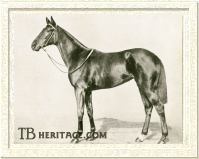
Molly Desmond
|
|
To the present day, MOLLY DESMOND'S tail-female line has produced over sixty horses which have either been classic winners, captured grade/group I events, or which have been influential in the stud, including Premonition (St. Leger); multiple French stakes winner and sire Luthier; English champion Brigadier Gerard; good stayers Fearless Fox and Philemon; influential stallion Nearctic, and 2010 Epsom Derby winner Workforce. MOLLY DESMOND died at the comparatively early age of fourteen in 1928.
|
Desmond's daughter, AYN HALI (1913), was a bay out of Lalla Rookh, by Hackler. She was a winner of the Anglesey Stakes and National Produce Stakes in Ireland at two, and was rated the second best juvenile filly in the U.K., behind Fifinella, although like many Desmonds, she could not stay and fell off at age three. She made a major contribution to the breed with her speedy son Sir Cosmo, a 1926 colt by The Boss, a son of Derby winner Orby.
Sir Cosmo captured several stakes, including the Exeter Stakes, Ribbesdale Stakes, and the prestigious July Cup. He passed on his brilliant speed, siring unbeaten juvenile champion Panorama; Irish Two Thousand Guineas winners Khosro and Good Morning; and Bellacose, a two-time winner of the July Cup. The lasting legacy of Sir Cosmo rests with his daughter Knight's Daughter. Bred by Lord Derby and foaled in 1941, Knight's Daughter was out of Aloe by the speed influence Friar Marcus. She was considered one of the fastest fillies of her generation when she blazed through three consecutive victories in her first three starts. An injury in her fourth and last race forced her retirement. Later acquired by the Hancock family's Claiborne Farm in Paris, Kentucky, she became an outstanding producer, garnering Broodmare of the Year honors in 1959. Mated with the stamina-laden Princequillo, she produced the full stakes-winning siblings Monarchy (an important broodmare in her own right) and Round Table, two-time handicap champion, three-time grass champion, Horse of the Year of 1958, and champion American sire in 1972. Round Table sired 83 stakes winners and was broodmare sire of over 100 stakes winners.
GRAND GERALDINE (1905), a black or brown filly out of Grand Marnier, by Friar's Balsam, was bred by M .R. Cleary. She never raced, and there was a story that she pulled a cart as a young filly. Whether a fanciful tale or not, she eventually became the property of Richard "Boss" Croker, the famous, or infamous, American politician who kept a stud in Ireland. Mated with Croker's 1907 Derby winner Orby, she produced the black colt Grand Parade in 1916. The colt was sold as a yearling to the 1st Baron Glanely for 470 guineas. Trained by Frank Barling at Newmarket, Grand Parade won five of six races at two, including the Anglesey Stakes and National Produce Stakes at the Curragh and the Fitzwilliam and Soltykoff Stakes at Newmarket. He concluded his two-year-old season with a third in the Moulton Stakes at Newmarket. Grand Parade had only two starts at three, and won them both. He made his seasonal debut in the Derby, and won by half a length from Viscount Astor's Buchan. His final racecourse appearance was a narrow victory in the St. James's Palace Stakes at Ascot.
Retired to Lord Glanely's stud at Exning for a fee of 400 guineas, Grand Parade did quite well. His get included Two Thousand Guineas winner Diophon, in turn sire of Two Thousand Guineas winner Diolite. The latter was a leading sire in Japan in 1942, 1943, and 1946. Diophon also got Irish Oaks victress Theresina, herself dam of Irish Derby and English St. Leger winner Turkhan and Ascot Gold Cup winner Ujiji. Diophon's French-bred, American-raced daughter Alberta was a winner of the Alabama Stakes at Saratoga in 1935. Other notable runners by Grand Parade included Irish Two Thousand Guineas winner Grand Joy; Gerarda delle Notte, winner in Italy of the Premio Regina Elena (Italian One Thousand Guineas); Greenore, winner of the Nunthorpe Stakes and Stewards Cup. Grand Parade was broodmare sire (via his daughter Point Duty), of English champion three-year-old filly Traffic Light, winner in 1936 of the Coronation Stakes and Park Hill Stakes. Grand Parade's daughter, Najmi, became the second dam of 1948 Epsom Derby and Grand Prix de Paris winner My Love. Arguably the greatest performer out of a Grand Parade mare was the German filly Nereide, unbeaten in all her ten starts in 1935 and 1936, including victories in the Preis der Diana (German Oaks) and the Deutsches Derby.
Grand Parade was destroyed in 1932 after breaking a leg. His dam, Grand Geraldine, the alleged cart horse who became the dam of a Derby winner, died in 1925, after being barren since 1917.
One Thousand Guineas heroine Bettina, who won the classic in 1921, was by Swynford out of Desmond's daughter BOBBINA (1911), a brown filly produced from the Orme mare Bobbin. TOOTIE (1903), out of Lady Castle, by Gallinule, became a classic producer in Germany when her son Turmfalke captured the 1913 Deutsches Derby. Doncaster Cup champion Devizes, who won that race in 1922, was sired by Valens and produced from Desmond's daughter DESLIONI (1910), who was out of the Royal Hampton mare Taglioni.
ARTICHOKE (1910), out of Fiorenza, by Orvieto, produced 1926 Anglesey Stakes winner Polecat (by Marten), and Chokolet (by My Prince), a filly which won two races in Ireland before being sold and sent to India, where she won a further six races. CANTRIP (1911) was a full sister to ABOYEUR, (out of Pawky, by Morion). She became the dam of the black colt Kirk Alloway, winner of the 1920 Irish St. Leger. DESMOND LASSIE (1912), a bay filly foaled from the St. Serf mare Edinglassie, proved a fine producer in France, as she was the dam of Irismond (Prix Lupin and Prix Noailles), Alguazil (Grand Prix de Vichy), and Esdarmonde (Prix la Rochette). MITYLENE (1914), out of Cyrilla, by Cyllene, became the dam of Greek Bachelor, a winner of the City and Suburban Handicap and third in the 1923 Irish Derby.
Greencap, a British-bred gelding by Martagon, was sold and spent his racing career in Australia. He was out of EMERALD (1904), Desmond's daughter out of Goldsmith Maid, by Derby winner Kisber. During the seasons of 1916 and 1917, Greencap was victorious in the October Stakes, Cumberland Stakes, the AJC Plate, and the Adelaide Cup. He was endowed with considerable stamina, winning from 12 to 24 furlongs.
Two major South African stakes winners were the products of Desmond mares. 1909 South African Derby winner Adair was sired by Broxton out of Desmond's South African-bred daughter MARY O'NEILL (1902), and 1916 Durban July Cup winner Margin was sired by Martagon out of COUNTESS OF DESMOND (1907). Mary O'Neill was out of Moanerla, by Kirkham, and Countess of Desmond had American blood, her dam, Favora, being an American-bred daughter of Himyar.
Desmond was broodmare sire of a Hungarian classic winner when his daughter MATHILDE (1905) produced Basa to the cover of Beregvolgy. In 1919, Basa was victorious in the Nemzeti dij (Hungarian Two Thousand Guineas) and the Alaji dij.
One other daughter of Desmond deserves mention: FLO DESMOND (1913), a bay out of Flighty Flo, by Flying Hackle. She became the cornerstone for a powerful family. Her daughter Nantenan (by Hainalt) produced Prince of Wales's Stakes winner Achtenan, and her daughter Saint Joan (by Willbrook) produced the exceptional mare Double Life (by Bachelor's Double). Double Life became the dam of Coronation Cup winner Persian Gulf, Ascot Gold Cup winner Precipitation, and Dewhurst and Burwell Stakes winner Casanova. Double Life's daughter Doubleton (by Bahram) produced Princess of Wales's Stakes winner Double Eclipse, major winner Nivrag, and Daily Double. The latter, by Fair Trial, became the dam of the English multiple classic winner Meld, in turn, the dam of Derby winner Charlottown.
Desmond died in the summer of 1913. The seemingly robust stallion was found dead in his stall on July 4, only a month after the dramatic events of Derby Day. An enlarged heart was found to be the cause of his sudden death. In passing at the relatively young age of seventeen, Desmond failed to match the record for longevity of three of his first four male line ancestors. St. Simon, Galopin, and the latter's grandsire Voltigeur each lived to the age of 27. Since Desmond was to lead the British sire list the year of his death, his loss was felt all the more keenly. In a little over a decade, Desmond went from entering stud with little promise, after his futile three-year-old season, to becoming one of the most successful sire sons of the mighty St. Simon. Desmond got horses that won races in Britain, Ireland, Italy, France, Hungary, Austria, Belgium, Germany, South Africa, Australia, Uruguay, Brazil, India, Russia, and Poland, including two champion sire sons in Australasia, and several leading broodmare sire sons. Some of his daughters, and those of his sons, had a profound impact on thoroughbred bloodstock. Desmond was buried at Fort Union Stud, and his horseshoe-shaped grave marker can still be seen today, a memorial to the horse, who, as his owner said, earned every bit of the success he achieved.
--Liz Martiniak
|
|
|
|

